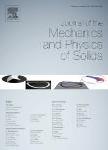版权所有:内蒙古大学图书馆 技术提供:维普资讯• 智图
内蒙古自治区呼和浩特市赛罕区大学西街235号 邮编: 010021

作者机构:Rockwell Int Sci Ctr Thousand Oaks CA 91360 USA Appl Res Associates Inc Nice Ville FL 32578 USA Univ Calif Santa Barbara Dept Mech & Environm Engn Santa Barbara CA 93106 USA
出 版 物:《JOURNAL OF THE MECHANICS AND PHYSICS OF SOLIDS》 (固体力学与固体物理学杂志)
年 卷 期:2003年第51卷第8期
页 面:1573-1600页
核心收录:
学科分类:08[工学] 0805[工学-材料科学与工程(可授工学、理学学位)] 0801[工学-力学(可授工学、理学学位)] 0702[理学-物理学]
基 金:U.S. Department of Energy, USDOE, (DE-FG03-97ER45667) Army Research Office, ARO, (DAAH04-95-C-0050)
主 题:fracture mechanisms microstructures fibre-reinforced composite material finite elements probability and statistics
摘 要:Prior experiments have revealed exceptionally high values of the work of fracture (0.4-1.1 MJm(-2)) in carbon/epoxy 3D interlock woven composites. Detailed destructive examination of specimens suggested that much of the work of fracture arose when the specimens were strained well beyond the failure of individual tows yet still carried loads similar to1 GPa. A mechanism of lock-up amongst broken tows sliding across the final tensile fracture surface was suggested as the means by which high loads could still be transferred after tow failure. In this paper, the roles of weave architecture and the distribution of flaws in the mechanics of tow lockup are investigated by Monte Carlo simulations using the so-called Binary Model. The Binary Model was introduced previously as a finite element formulation specialised to the problem of simulating relatively large, three-dimensional segments of textile composites, without any assumption of periodicity or other symmetry, while preserving the architecture and topology of the tow arrangement. The simulations succeed in reproducing all qualitative aspects of measured stress-strain curves. They reveal that lockup can indeed account for high loads being sustained beyond tow failure, provided flaws in tows have certain spatial distributions. The importance of the interlock architecture in enhancing friction by holding asperities on sliding fibre tows into firm contact is highlighted. (C) 2003 Elsevier Science Ltd. All rights reserved.